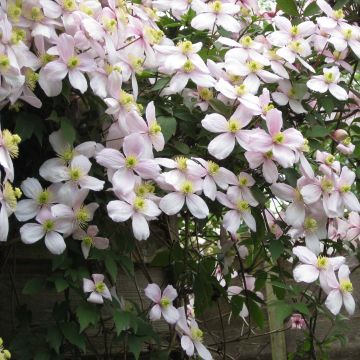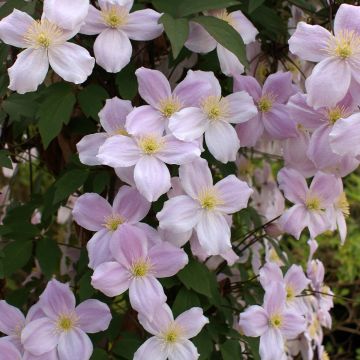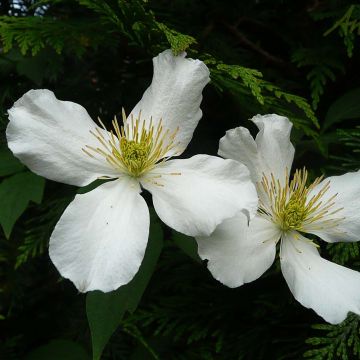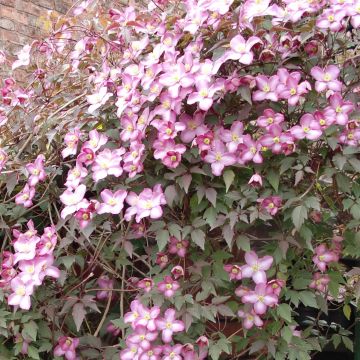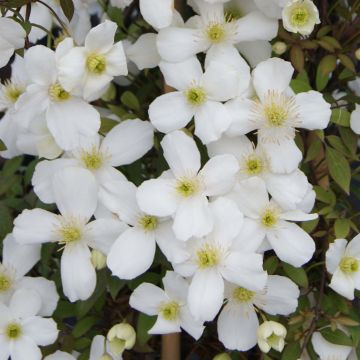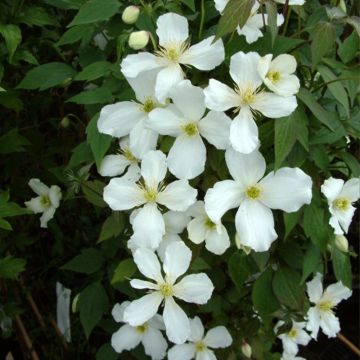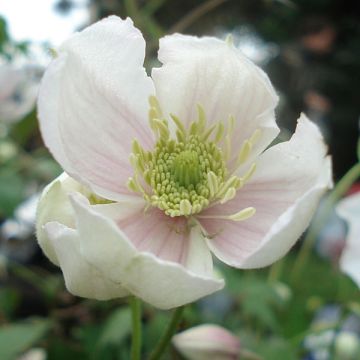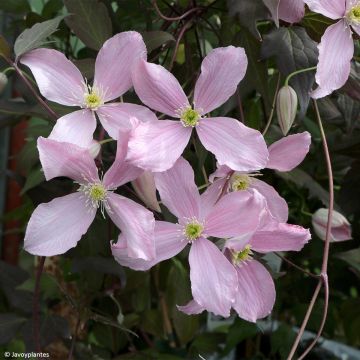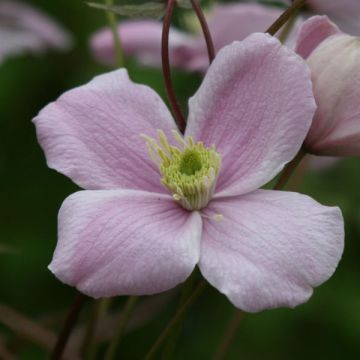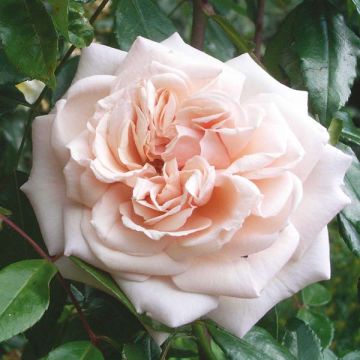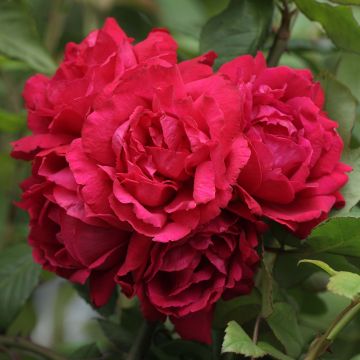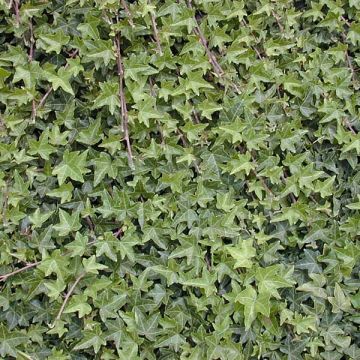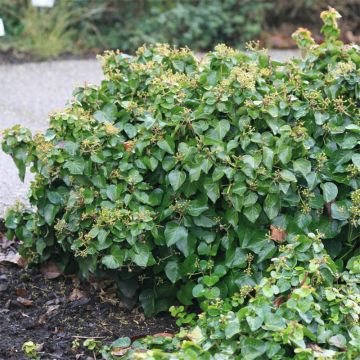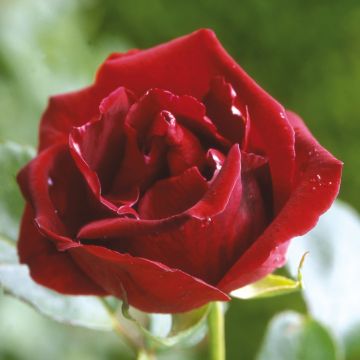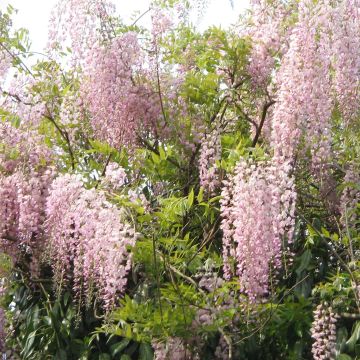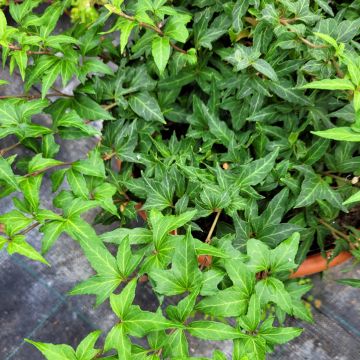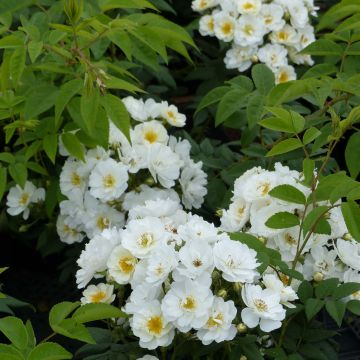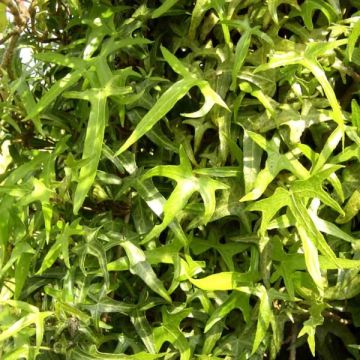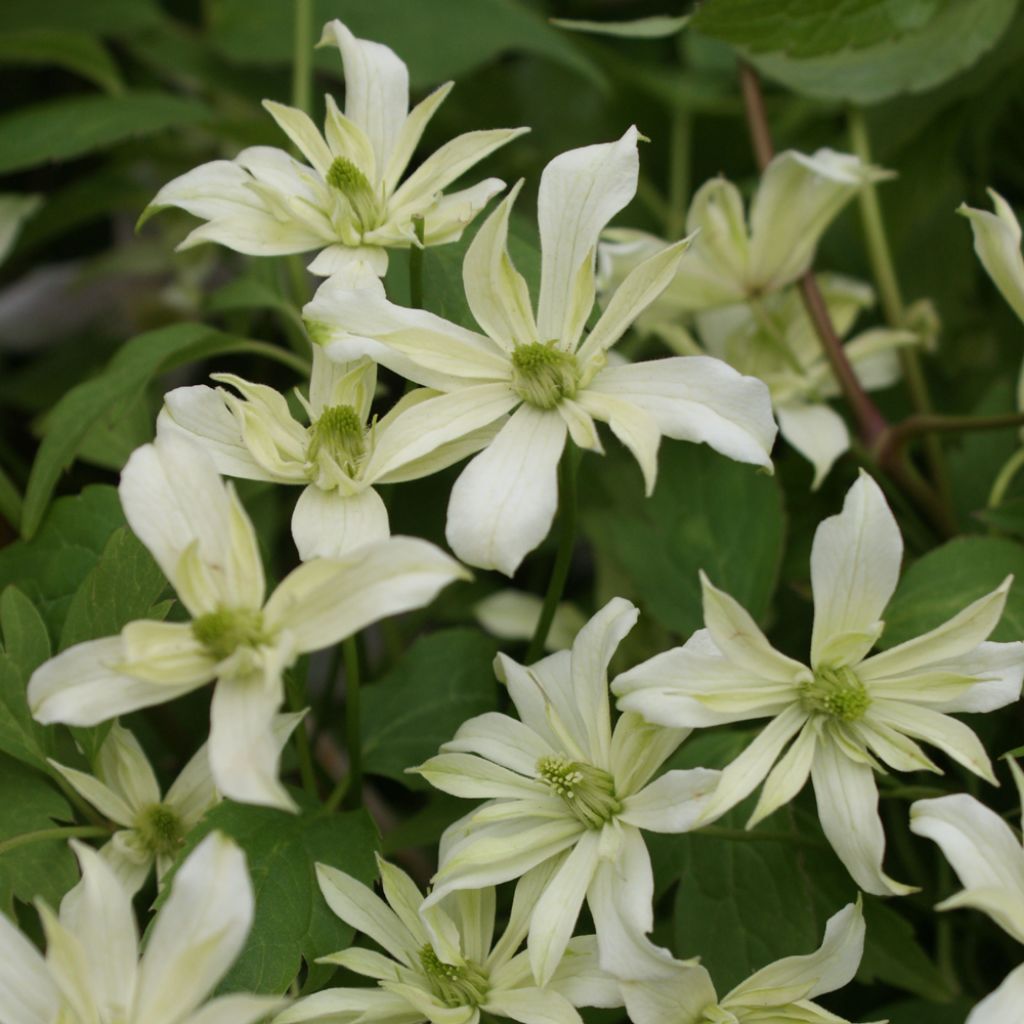

Clematite Jenny Keay - Clematis x montana
Clematis montana Jenny Keay
Clematis montana x spooneri Jenny Keay
Clematis montana
Good reception and perfect recovery. The stems are slender but sturdy, and I will soon be able to see its flowers as it is in bud.
Marie-Andrée, 01/05/2020
This item cannot be shipped to the selected country
Delivery charge from €5.90
More information
Schedule delivery date,
and select date in basket
This plant carries a 6 months recovery warranty
More information
We guarantee the quality of our plants for a full growing cycle, and will replace at our expense any plant that fails to recover under normal climatic and planting conditions.
From €5.90 for pickup delivery and €6.90 for home delivery
Express home delivery from €8.90.
Does this plant fit my garden?
Set up your Plantfit profile →
Description
Clematis Jenny Keay is a form of Clematis montana with a unique appearance and delightful flowers. Its flowers are large, simply beautiful, and single or semi-double. Their colour ranges from white to very pale green when they bloom in the shade, while they blush salmon pink in the sun. Pale green stamens complete this gentle harmony. This variety is not as vigorous as the usual forms of Clematis montana, its growth is slower and it develops shorter internodes. This will mean it can thrive in a container or large pot on the terrace. It will thrive in full sun or partial shade, in moist, deep, fertile soil.
'Jenny Keay' is a semi-woody, climbing perennial plant belonging to the buttercup family, obtained in New Zealand. Of modest size for a C. montana, it will slowly reach 3 to 3.50 metres (10 to 11 feet) high, with a spread of 1 square metre. This variety is likely the result of cross-breeding between Clematis montana, native to the Himalayas, and Clematis spooneri, native to China, both of which have single, very pale pink flowers and resemble each other.
This clematis bears double or semi-double flowers, of medium size, with a diameter of 6 to 7 cm (2 to 3in), which bloom abundantly in May-June, long after the other C. montana have finished flowering. The flowers are grouped in axillary clusters of 1 to 5 flowers on long pedicels. They appear on the previous year's branches. Resembling slightly loose but well-ordered pompoms, they have numerous thin, tapering tepals gracefully open in a star shape with green stamens at their centre. They are infinitely delicate, ivory white washed with almond green in the centre, edged with salmon pink when exposed to sunlight. The flowers are followed by decorative, feathery, silvery grey seed heads. The leaves are simple and tri palmate, with irregularly serrated edges, coppery when young, then olive green, in perfect harmony with the watercolour flower colours. This clematis clings to its support or host plant with tendrils.
Plant clematis alongside your climbing roses to extend the flowering of your walls and pergolas until the end of summer. This is a genus rich in diversity, with flowers in all colours, shapes, and sizes. Take advantage of their easy cultivation to give your garden a touch of romance and bohemian charm. 'Jenny Keay', thanks to its relatively small size, will also thrive in a pot on a balcony or next to an entrance door to welcome visitors with its truly delightful flowering. Give it to a gardening friend as a beautiful gift.
Tips: Avoid excessive fertiliser that encourages foliage at the expense of flowers. Do not mulch, to avoid excessive moisture that promotes clematis wilt.
Report an error about the product description
Clematis montana Jenny Keay in pictures
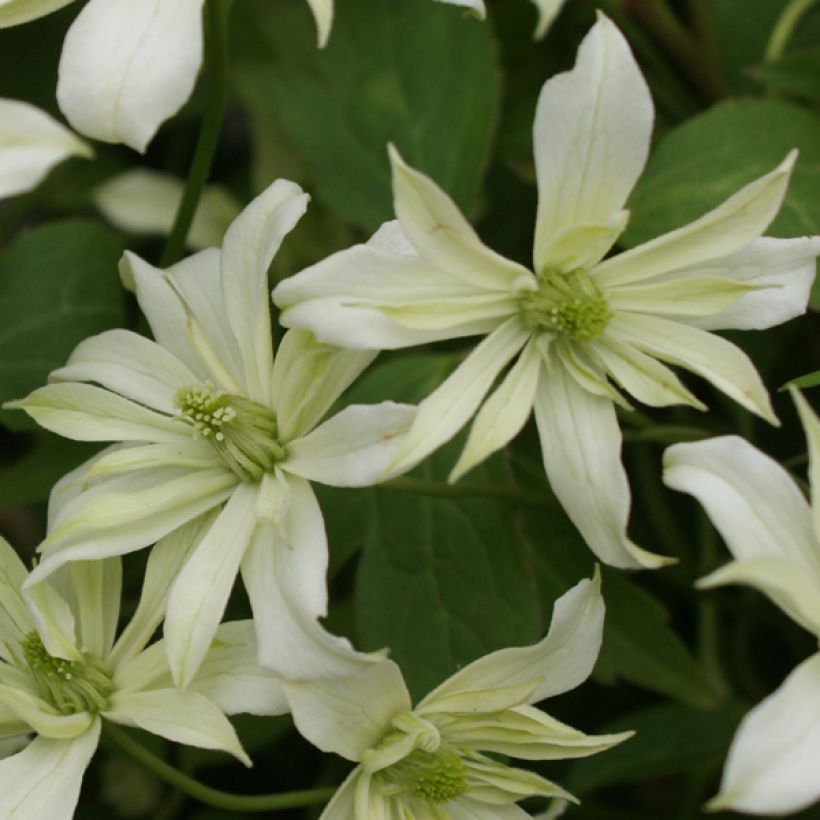

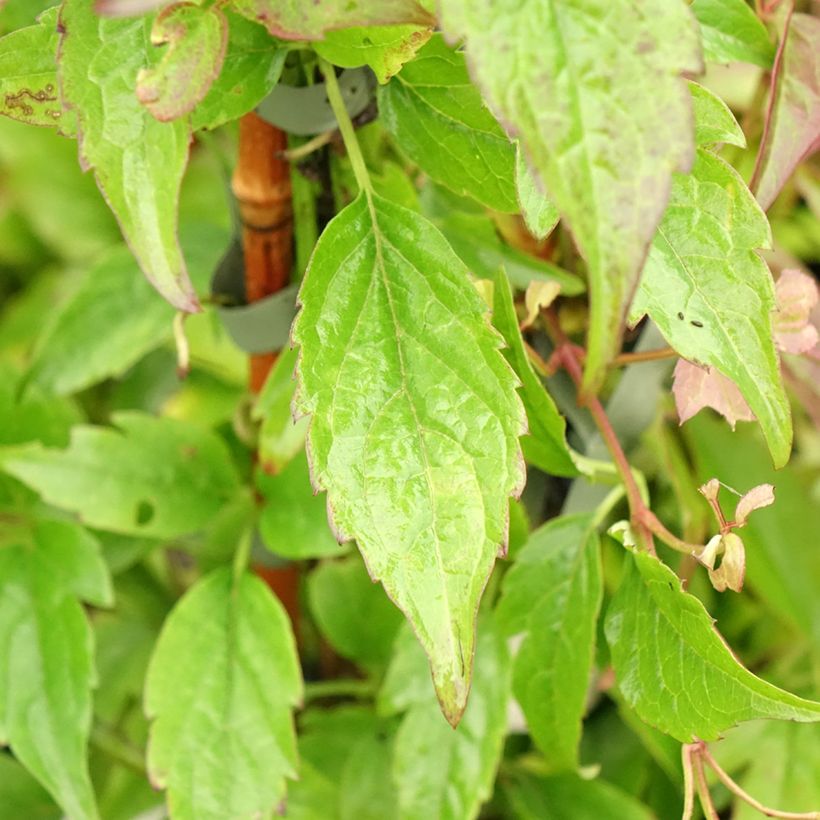

Plant habit
Flowering
Foliage
Botanical data
Clematis
montana x spooneri
Jenny Keay
Ranunculaceae
Clematis montana
Cultivar or hybrid
Other Clematis Montana
Planting and care
Clematis montana 'Jenny Keay' should be planted in spring or autumn at a depth of 5cm (2in), with the root ball placed flat on the ground rather than vertically as usual. The head should be in the sun and the base in the shade. The soil should be well-drained, well-cultivated, and fairly fertile and remain moist in summer, although after a few years, the clematis can tolerate some drought. Cover the base with a small mound of soil to encourage new shoots. After planting, prune the stems to 30cm (12in) from the base, above a pair of buds. Train stems loosely until the plant climbs on its own. Later pruning will involve removing any dead or damaged stems, either at the end of winter or after flowering.
Planting period
Intended location
Care
-
, onOrder confirmed
Reply from on Promesse de fleurs
Foolproof climbers
Haven't found what you were looking for?
Hardiness is the lowest winter temperature a plant can endure without suffering serious damage or even dying. However, hardiness is affected by location (a sheltered area, such as a patio), protection (winter cover) and soil type (hardiness is improved by well-drained soil).

Photo Sharing Terms & Conditions
In order to encourage gardeners to interact and share their experiences, Promesse de fleurs offers various media enabling content to be uploaded onto its Site - in particular via the ‘Photo sharing’ module.
The User agrees to refrain from:
- Posting any content that is illegal, prejudicial, insulting, racist, inciteful to hatred, revisionist, contrary to public decency, that infringes on privacy or on the privacy rights of third parties, in particular the publicity rights of persons and goods, intellectual property rights, or the right to privacy.
- Submitting content on behalf of a third party;
- Impersonate the identity of a third party and/or publish any personal information about a third party;
In general, the User undertakes to refrain from any unethical behaviour.
All Content (in particular text, comments, files, images, photos, videos, creative works, etc.), which may be subject to property or intellectual property rights, image or other private rights, shall remain the property of the User, subject to the limited rights granted by the terms of the licence granted by Promesse de fleurs as stated below. Users are at liberty to publish or not to publish such Content on the Site, notably via the ‘Photo Sharing’ facility, and accept that this Content shall be made public and freely accessible, notably on the Internet.
Users further acknowledge, undertake to have ,and guarantee that they hold all necessary rights and permissions to publish such material on the Site, in particular with regard to the legislation in force pertaining to any privacy, property, intellectual property, image, or contractual rights, or rights of any other nature. By publishing such Content on the Site, Users acknowledge accepting full liability as publishers of the Content within the meaning of the law, and grant Promesse de fleurs, free of charge, an inclusive, worldwide licence for the said Content for the entire duration of its publication, including all reproduction, representation, up/downloading, displaying, performing, transmission, and storage rights.
Users also grant permission for their name to be linked to the Content and accept that this link may not always be made available.
By engaging in posting material, Users consent to their Content becoming automatically accessible on the Internet, in particular on other sites and/or blogs and/or web pages of the Promesse de fleurs site, including in particular social pages and the Promesse de fleurs catalogue.
Users may secure the removal of entrusted content free of charge by issuing a simple request via our contact form.
The flowering period indicated on our website applies to countries and regions located in USDA zone 8 (France, the United Kingdom, Ireland, the Netherlands, etc.)
It will vary according to where you live:
- In zones 9 to 10 (Italy, Spain, Greece, etc.), flowering will occur about 2 to 4 weeks earlier.
- In zones 6 to 7 (Germany, Poland, Slovenia, and lower mountainous regions), flowering will be delayed by 2 to 3 weeks.
- In zone 5 (Central Europe, Scandinavia), blooming will be delayed by 3 to 5 weeks.
In temperate climates, pruning of spring-flowering shrubs (forsythia, spireas, etc.) should be done just after flowering.
Pruning of summer-flowering shrubs (Indian Lilac, Perovskia, etc.) can be done in winter or spring.
In cold regions as well as with frost-sensitive plants, avoid pruning too early when severe frosts may still occur.
The planting period indicated on our website applies to countries and regions located in USDA zone 8 (France, United Kingdom, Ireland, Netherlands).
It will vary according to where you live:
- In Mediterranean zones (Marseille, Madrid, Milan, etc.), autumn and winter are the best planting periods.
- In continental zones (Strasbourg, Munich, Vienna, etc.), delay planting by 2 to 3 weeks in spring and bring it forward by 2 to 4 weeks in autumn.
- In mountainous regions (the Alps, Pyrenees, Carpathians, etc.), it is best to plant in late spring (May-June) or late summer (August-September).
The harvesting period indicated on our website applies to countries and regions in USDA zone 8 (France, England, Ireland, the Netherlands).
In colder areas (Scandinavia, Poland, Austria...) fruit and vegetable harvests are likely to be delayed by 3-4 weeks.
In warmer areas (Italy, Spain, Greece, etc.), harvesting will probably take place earlier, depending on weather conditions.
The sowing periods indicated on our website apply to countries and regions within USDA Zone 8 (France, UK, Ireland, Netherlands).
In colder areas (Scandinavia, Poland, Austria...), delay any outdoor sowing by 3-4 weeks, or sow under glass.
In warmer climes (Italy, Spain, Greece, etc.), bring outdoor sowing forward by a few weeks.

































